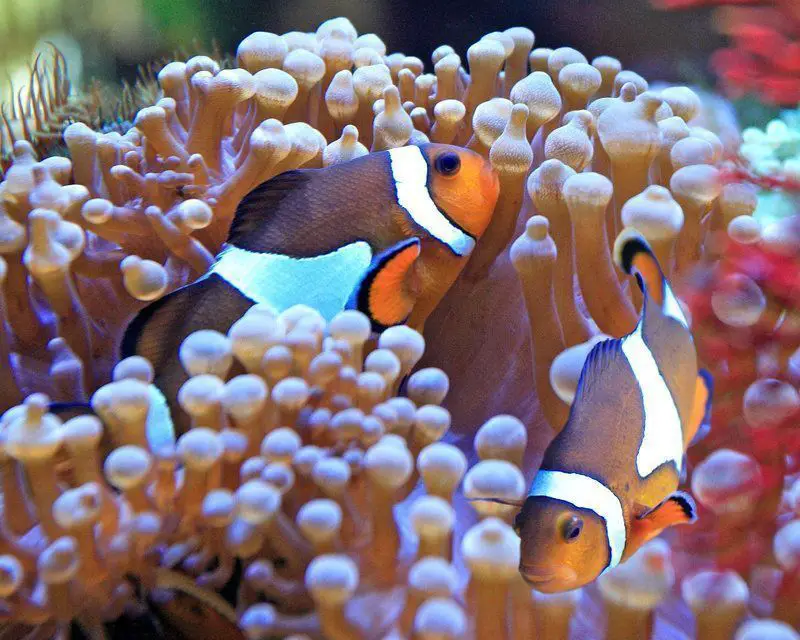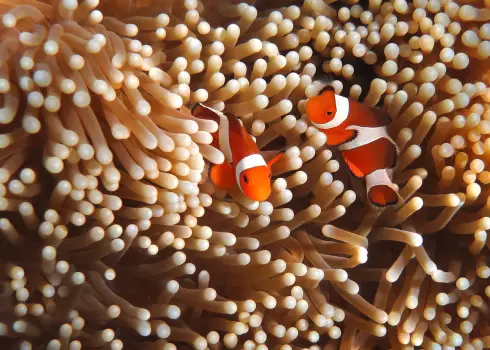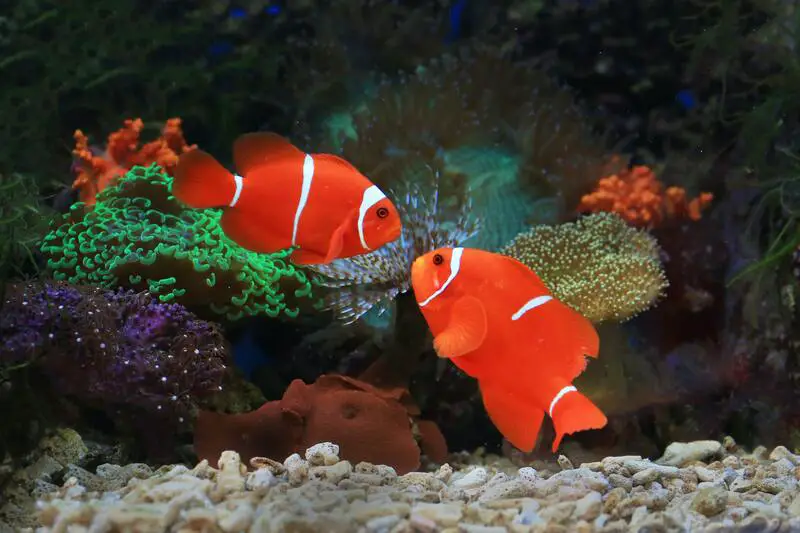Introduction
Clownfish have a very intriguing social system. Some fascinating behaviors clownfish engage in include changing gender, eliminating competition, and upholding some order in their environment contingent on their size.
Although we know they ultimately become parents, do clownfish mate for life?
Should you start with a breeding pair instead of a lone clownfish? These answers and more will be covered in our article!
Do Clownfish Mate for Life?
Since clownfish are naturally monogamous, their unions are essentially permanent, answering the “do clownfish mate for life” question.
However, they differ in other behaviors from most tank fish. There are some considerations you should make before purchasing them.
Clownfish are first and foremost protandrous hermaphrodites. They were all born males. But at a particular stage of life, they switch to females.
They are naturally monogamous in part because of this. A female clownfish can only mate with one male throughout her lifetime.

When people learn that clownfish exist in schools made up of females and several males, they’re usually surprised to learn that the fish is monogamous. The most dominant and biggest clownfish is always a female.
A male who is her mate serves as the next in charge. He’s the most enormous and ferocious of the fish, aside from the female. Clownfish exist in purely hierarchical communities. The fish underneath dominant females are ordered by their sizes.
Every one of them isn’t as big as this female. That’s not a product of chance. The male partner of the female works hard to get her some benefits the school offers.
He does not just get to procreate with females, but he also gets to hoard the tastiest food for her. He contributes to keeping the males below him tiny by doing this.
In a clownfish school, much smaller males would encounter physical resistance while attempting to pair with the dominant female.
But you’ll also discover that a lot of the males are sterile. As a result, they aren’t even at an advantage in mating with the female clownfish.
The female decides to mate. She’ll choose the ideal breeding mate among the alternatives open to her.
The group’s most significant and authoritative male is usually the one she chooses. The males bite, chase, and stretch their fins to differentiate themselves from their competitors.
Even after female clownfish select the male they’d like to mate with; this courtship activity will continue in some way; at the barest minimum, these males would become increasingly hostile during spawning.
The order will alter when males are selected to be mated. Every other fish under this beta male would move up in response to his advancement. These changes are never really significant.
Only one level is added to the organizational hierarchy for the most prominent, dominant males. Because of his elevated position and ability to hoard the choicest food, it will eventually become bigger.
There’s just one female inside the tank; therefore, you’ll find only the breeding couple once she selects a male. On bare rocks, males construct nests. These nests will be placed next to your anemone if you’ve got one.
The male will finally bring the female back into the nest. Clownfish lay eggs between several hundred to even a thousand. The male would take control when everything was over.
It’ll fertilize the female-laid clownfish eggs, take care of them, and massage them using its fins to clean them up. The male clownfish will eat clownfish eggs that are broken or sterile.
The parental responsibilities of male clownfish finish after hatching the clownfish eggs, typically requiring ten days.
What Transpires When a Clownfish Mate Dies?
When a female clownfish dies, the situation inside the tank will take a fantastic twist.
By obtaining the first pick of nourishment at this stage, the beta male clownfish will start to gain weight. It’d later assume the role of the new breeding female and occupy the position of authority.
As a result, the biggest non-breeding male will take over as the beta male. The young fish below will move up one level, causing the hierarchy to change again.
This new clownfish female has the ultimate authority on matters involving her new clownfish male spouse and the other fish in her school.

This new breeding couple will lay extra clownfish eggs when they spawn.
The female uses violence to dominate her male spouse and the young fish below. This enables her to establish dominance and stop the formation of additional females.
The beta male changes into a female after the death of the new female clownfish. Another beta male is selected, and the cycle is repeated.
Clownfish Monogamy and the Function of Anemones
Clownfish’s life cycle has been linked to their association with sea anemones.
Anemones are organisms that resemble plants quite well. They employ poison to immobilize other marine animals they come across before eating them, yet they’re still very much living.
Since they thrive in anemones, clownfish are unusual. While some researchers have hypothesized that they have some form of immunity or protective mechanism that shields them from the painful stings of anemones, nobody is certain why they don’t sting clownfish and devour them.
Whatever the reason, anemones and clownfish share a mutually beneficial interaction that benefits both.
Anemones serve as a home for clownfish. The animals, in turn, protect anemones from the activity of predators, which mostly avoid the anemone’s poisonous stingers.
Also, clownfish consume the anemone’s waste products.
Clownfish have evolved a breeding approach that restricts the number of spawning possibilities by guaranteeing that every school has only a breeding couple due to the restricted area the anemones provide.
The younger fish who live in the same anemone as the beta male and alpha female may have altered their development rate with time to render them submissive and small, decreasing the likelihood that the dominant fish would kick them out.
It must be emphasized that while sharing an anemone with some other non-breeding male fish is rather frequent; you may also encounter mating couples that live by themselves in a sea anemone.
Anemones can sometimes be neglected, even though they are necessary for reproduction and survival.
Can Female Clownfish Switch Partners?
Nobody is quite certain of the answer since studying the clownfish reproductive cycle is still somewhat limited.
It is difficult to predict what will occur if a tank with a beta male and an alpha female already has another dominant male.

Some claim that if these new male clownfish were stronger, bigger, and more belligerent, the female clownfish would reject her partner.
This they do to select and reproduce with the best option inside their tank, which is how the females are.
His dominance and size determine a male clownfish’s appropriateness. This supports the idea that female clownfish will leave a non-desirable partner for a superior one.
But there isn’t any scientific data to back up these beliefs. Clownfish are entirely monogamous, as everyone knows. They only switch partners after the demise of the female.
How Do Clownfish Alter Their Sexual Identity?
How a clownfish’s reproductive process begins may be a mystery to some. After the clownfish mate dies, the beta male replaces her, and a top-ranking younger clownfish becomes the next beta male to take over.
But then, how does the whole thing start?
Where do the female clownfish originate from if there is just a male fish in the tank? The answer is still the same. Clownfish are born as males; however, along the line, they change to female for reproduction and continuity.
They are hierarchical, as previously indicated; therefore, if you’ve got two males clownfish inside a tank, they’ll battle for supremacy.
The winning clownfish will mature into a female after proving its supremacy.
According to researchers, the brain, not the gonads, is where this gender transformation begins. Several male fish were put inside a tank as part of an investigative study. Sometimes the dominant male didn’t show up for minutes.
The other lower males required hours to show up. When this happens, the dominant male begins behaving as much as a female clownfish even when his gonads are still male.
The preoptic region of its brain, which regulates gonad activity, was thus given more attention by the scientists conducting the study.
Preoptic areas in female clownfish are bigger and contain double as many neurons as their male counterparts.
In the following months, the scientists examined the brains of the dominant clownfish male who’d appeared among the participants.
The scientists found out that each of the dominant male’s preoptic regions had expanded to resemble the preoptic tract of a female.
The dominant male’s gonads hadn’t altered, but the brain had turned female.
Anyone who examined the brain of the dominant male would have classified them as female. Their physical actions would have reinforced this judgment.
Notwithstanding the incitement, the other male clownfish exhibited little interest in challenging the dominating fish. Clownfish males wouldn’t ever attack a female.
The scientists found that while the brain changed into that of a female pretty quickly, the gonads changed into a female significantly more slowly.
Just three dominant males entirely transformed into females out of the seventeen fish they experimented on.
The other fish continued to act in a state of limbo. Their gonads were male, yet their brains were feminine. The ability of clownfish to manage their gender change was ultimately boosted further by this.
Even after observing for three years, researchers could not determine why many of their test subjects refused or failed to make the required change.
Will a Lone Clownfish Still Alter its Sexual Identity?

While most clownfish will switch sexes at some point in their lives, others may remain lone and male their whole lives.
As protandrous hermaphrodites, they are capable of possessing both male and female reproductive organs. But they won’t switch sexes until they discover a mate with an identical gender.
A clownfish can switch sexes in captivity if it’s unable to locate a suitable spouse in its natural environment to have offspring.
Does Switching Sex Make Clownfish More Aggressive?
There isn’t any proof that suggests that clownfish become more aggressive when their sex changes. Most clownfish seem fairly friendly and calm when not engaged in sexual reproduction.
Can a Clownfish Be Kept Alone?
If you love documentaries, you may have seen clown fish living in pairs in sea anemones. But you may be wondering do clownfish need to live in pairs? The quick answer is yes, \ou can keep a solitary clownfish inside a tank.
But, this is not ideal. Clownfish need groups’ enthusiasm to grow and maintain order in their school. That would be a crucial aspect of the clownfish’s existence that should not be joked with.
Males of the clownfish, a species that lives exclusively in an anemone with which they share a symbiotic relationship, can change sex if their mating partner dies.
The same fish can reproduce as both a female and a male due to their ease of gender transition. Together, the pair guards the anemone in their ways and depend on one another to live and procreate.
Growing clownfish in couples is the best option if you want to replicate how they exist in their natural environment. But even so, don’t forget that you will need a very big tank.
Conclusion
Clownfish have lifelong partners because they’re naturally monogamous. The next most conspicuous male in the group will often approach a female clownfish. Female clownfish will mate with the most dominant male.
For the remainder of their lives, these two clownfish will be together. Although there is little information on this subject, adding a more conspicuous beta male could disrupt the current order.

